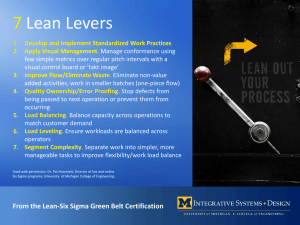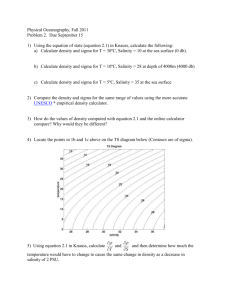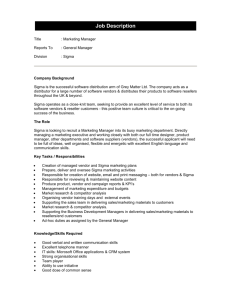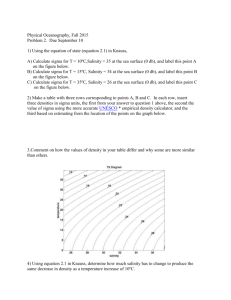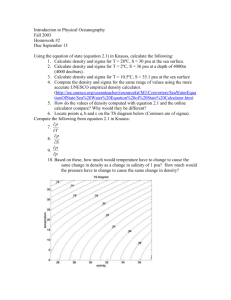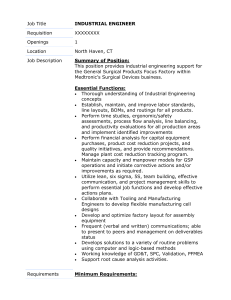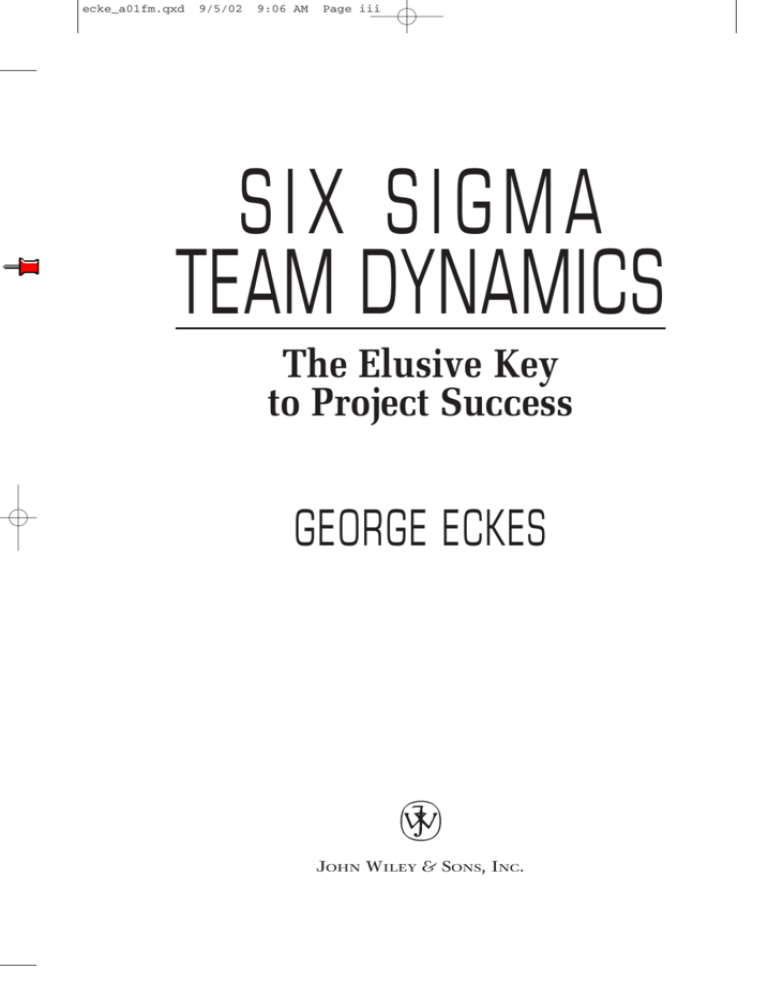
ecke_a01fm.qxd
9/5/02
9:06 AM
Page iii
SIX SIGMA
TEAM DYNAMICS
The Elusive Key
to Project Success
GEORGE ECKES
JOHN WILEY & SONS, INC.
ecke_a01fm.qxd
9/5/02
9:06 AM
Page ii
ecke_a01fm.qxd
9/5/02
9:06 AM
Page i
SIX SIGMA
TEAM DYNAMICS
ecke_a01fm.qxd
9/5/02
9:06 AM
Page ii
ecke_a01fm.qxd
9/5/02
9:06 AM
Page iii
SIX SIGMA
TEAM DYNAMICS
The Elusive Key
to Project Success
GEORGE ECKES
JOHN WILEY & SONS, INC.
ecke_a01fm.qxd
9/5/02
9:06 AM
Page iv
Copyright © 2003 by George Eckes. All rights reserved.
Published by John Wiley & Sons, Inc., Hoboken, New Jersey.
Published simultaneously in Canada.
No part of this publication may be reproduced, stored in a retrieval system,
or transmitted in any form or by any means, electronic, mechanical,
photocopying, recording, scanning, or otherwise, except as permitted under
Section 107 or 108 of the 1976 United States Copyright Act, without either
the prior written permission of the Publisher, or authorization through
payment of the appropriate per-copy fee to the Copyright Clearance Center,
Inc., 222 Rosewood Drive, Danvers, MA 01923, (978) 750-8400, fax (978)
750-4470, or on the web at www.copyright.com. Requests to the Publisher
for permission should be addressed to the Permissions Department, John
Wiley & Sons, Inc., 111 River Street, Hoboken, NJ 07030, (201) 748-6011, fax
(201) 748-6008, e-mail: permcoordinator@wiley.com.
Limit of Liability/Disclaimer of Warranty: While the publisher and author
have used their best efforts in preparing this book, they make no
representations or warranties with respect to the accuracy or completeness
of the contents of this book and specifically disclaim any implied
warranties of merchantability or fitness for a particular purpose. No
warranty may be created or extended by sales representatives or written
sales materials. The advice and strategies contained herein may not be
suitable for your situation. The publisher is not engaged in rendering
professional services, and you should consult a professional where
appropriate. Neither the publisher nor author shall be liable for any loss of
profit or any other commercial damages, including but not limited to
special, incidental, consequential, or other damages.
For general information on our other products and services please contact
our Customer Care Department within the U.S. at (800) 762-2974, outside
the United States at (317) 572-3993 or fax (317) 572-4002.
Wiley also publishes its books in a variety of electronic formats. Some
content that appears in print may not be available in electronic books.
Library of Congress Cataloging-in-Publication Data:
Eckes, George, 1954–
Six sigma team dynamics : the elusive key to project success / George
Eckes.
p. cm.
Includes bibliographical references and index.
ISBN 0-471-22277-1 (CLOTH : alk. paper)
1. Teams in the workplace. 2. Project management. 3. Leadership.
I. Title.
HD66 .E324
2002
658.4′04—dc21
2002006584
Printed in the United States of America.
10 9 8 7 6 5 4 3 2 1
ecke_a01fm.qxd
9/5/02
9:06 AM
Page v
To my dear Uncle Joseph Della Malva,
it has been an honor being a part of your “team.”
And to the memory of my sister, Adrienne.
You left our “team” too soon.
ecke_a01fm.qxd
9/5/02
9:06 AM
Page vi
ecke_a01fm.qxd
9/5/02
9:06 AM
Page vii
Foreword
As the Business Leader for Household Retail Services, I have become
keenly aware of the impact Six Sigma, as a management philosophy,
can have in managing a business. Both in my current responsibilities
and in my previous career at General Electric, I have seen the power
of Six Sigma firsthand in helping my organization improve both its
effectiveness and efficiency.
We have embraced Six Sigma at Household Retail Services since
early 2001. Having worked with George Eckes at General Electric, I
knew he had a results-driven approach. Since Household Retail Services contracted with Eckes and Associates Inc., we have had impressive success.
A key ingredient in our success was embracing Six Sigma as a management strategy. Beginning in the spring of 2001 we created our Six
Sigma Business Process Management System. My management team
and I aligned our core and subprocesses to our business objectives and
began to collect data on measures of both effectiveness and efficiency.
By the summer of 2001, we had selected nine low-performing, highimpact projects for improvement. Over the course of the next six
months, George Eckes and his staff trained our project improvement
teams to apply Six Sigma tactically. By year-end 2001, we were celebrating our first round of successes. These successes included reducing dispute resolution from an average of 38 days to less than 3, and
dramatically reducing incidences of fraud.
Which brings me to the topic of George’s third book on Six Sigma,
Six Sigma Team Dynamics: The Elusive Key to Project Success. The tools
vii
ecke_a01fm.qxd
viii
9/5/02
➤
9:06 AM
Page viii
FOREWORD
and techniques of Six Sigma at the tactical level are relatively simple
to use once a team gains some experience in their application. Of
much greater difficulty is managing the team and its interactions.
When managed properly, team dynamics can result in a significant
increase in Six Sigma project success. When ignored, they can result
in the failure of the project team to meet its goals and objectives.
As he did in his first two books on Six Sigma, The Six Sigma Revolution: How General Electric and Others Turned Process into Profits and
Making Six Sigma Last: Managing the Balance Between Cultural and
Technical Change, George communicates the key concepts of managing Six Sigma team dynamics in easy to understand language.
In Chapter 2, he begins with an explanation of the roles and responsibilities of a Six Sigma team. Included in this discussion are the
roles of the business leader, the project sponsor (also known as the
Project Champion), the team leader, and team members. In pragmatic fashion, George lays out eleven action items the Project Champion should address even before the project team meets for the first
time. In subsequent chapters (Chapters 5 and 7), George discusses
what a good Champion should do during the project and describes
the responsibilities of the Champion after the team disbands.
Good Six Sigma team dynamics requires a combination of preventions and interventions. As the saying goes, “An ounce of prevention
is worth a pound of cure.” In Six Sigma, the modified version of the
adage rightfully states, “An ounce of prevention is worth a pound of
intervention.” This adage is directly applicable to Six Sigma teams
and their dynamics. In Chapter 3, George lays out detailed, common
sense preventions that can dramatically increase the achievement of
the Six Sigma team’s goals and objectives. They include how to create
meaningful agendas so that teams break down their project work into
bite-sized pieces. Suggestions on which tools to use to address each
agenda item are given as well as suggestions on the importance of
providing time limits to achieve goals. Another prevention included
is how to set meaningful ground rules for each Six Sigma meeting.
Ground rules are one element of facilitation that are intended to help
prevent maladaptive behaviors from interfering with the work of
achieving Six Sigma improvement. They are conventions that assist a
team in establishing a set of acceptable and unacceptable behaviors so
that the work of the team is not detoured by maladaptive behaviors.
Despite the best efforts of any team to prevent maladaptive behaviors, they will occur. In Chapters 4, 6, and 7, George provides specific
suggestions as to how to deal with those behaviors, including how a
team member should handle minor disruptions to the more severe situation of how the team Champion must handle an intransient resistor.
ecke_a01fm.qxd
9/5/02
9:06 AM
Page ix
Foreword
➤
ix
The ability to utilize project management tools is often a missing
ingredient in Six Sigma teams. Simple but effective tools like Work
Breakdown charts, Linear Responsibility charts, and Activity Reports
can dramatically improve the effectiveness and efficiency of the time
a Six Sigma team devotes to their project. These tools address the
common complaint from teams that they don’t have the time for Six
Sigma. Understandably, this complaint is often voiced by more disorganized teams that waste valuable time between training sessions. In
Chapter 5, George addresses how to use a sample of project management tools to expedite a Six Sigma team’s work.
George takes a unique approach in his third book by combining
detailed information on Six Sigma team dynamics through a fictionalized financial services organization. This fictionalized organization, Alpha Omega, is easily recognized as a representation of any
organization that you may encounter.
Like his first two books, each chapter ends with a list of Key
Learnings. A new addition to his third work is three appendices that
I found particularly valuable. Appendix A includes the templates
used by the fictitious call center team that attempted to improve effectiveness and efficiency at Alpha Omega. Of particular value is Appendix B where George provides 95 questions good Champions
should ask their teams during the Define, Measure, Analyze, Improve, and Control stages of the improvement process. Appendix C is
the list of specific responsibilities of the Project Champion. These include detailed action items to use before the Champion forms the
team, during the team’s four- to six-month existence, and after the
team disbands.
Six Sigma, as a management philosophy, can be a major factor
in achieving your business objectives, but only if done right. Six
Sigma Team Dynamics: The Elusive Key to Project Success can help
you get there.
SANDRA DERICKSON
Managing Director and CEO,
Household Retail Services
ecke_a01fm.qxd
9/5/02
9:06 AM
Page x
ecke_a01fm.qxd
9/5/02
9:06 AM
Page xi
Preface
Joseph Della Malva was born on July 13, 1917, to Italian immigrants.
His father Michael was born in Rodi Garganico on the Adriatic coast of
Italy and settled in Hoboken, New Jersey, when he came to this country in 1906. A widower with a six-year-old son, Michael married Assunta De Felice, also from Rodi, in 1916. They moved to West Hoboken,
where Joseph was born the next year. The Della Malva family, which
by then included two daughters, eventually moved to Jersey City.
Joseph Della Malva was a bright, inquisitive young man who led
an amazingly diverse life, that included acting on Broadway in the
late 1930s. As a result of his high school studies, he was fluent in several languages, leading to a job as a translator in New York City. However, in spite of remarkable life experiences, nothing could have fully
prepared him for the world events of the early 1940s.
At the age of 23, Joseph volunteered for military service. He was
stationed in the Philippines in December 1940. In February 1941, he
was transferred by secret orders to Military Intelligence in Manila,
with the rank of special agent. As a special agent, he conducted
investigations of Nazis, fascists, and subversive activities in the
Philippines. On November 28, 1941, Joseph transferred to Sea Coast
artillery on Corregidor, the fortified island opposite the Bataan
peninsula.
The Philippines became engaged in hostile actions against Japanese forces on December 8, 1941. Ultimately, after fighting against
overwhelming odds, the American and Filipino defenders on Bataan
xi
ecke_a01fm.qxd
xii
➤
9/5/02
9:06 AM
Page xii
PREFACE
surrendered to the Japanese on April 9, 1942. Corregidor fell 28 days
later, on May 6th. Joseph Della Malva became a prisoner of war, and
was held captive for the next three years and four months, until liberation in September 1945.
Six months after his initial capture, he was transferred by prison
ship (which was barely missed in a torpedo attack by a U.S. submarine)
to Japan, where he did hard labor at locations throughout Japan. He
was a railroad freight yard worker in Osaka, a construction worker
for a dry-dock in Tanagawa, a graphite factory worker in Naru, and finally, during the last five months of the war, as a stevedore on the
docks of Tsuruga, a seaport on the west coast of Japan. Unlike POWs
in Europe, POWs in Japan were as likely to die on Japanese soil as
they were to return to the United States.
There were a host of reasons why Joseph Della Malva survived.
He had tremendous emotional strength, which was instilled in him
during his youth. He learned at his father’s knee the importance of
being strong. Being an Italian immigrant in the early twentieth century meant being ridiculed and harassed. He learned early to withstand the taunts of those who were less intelligent than he was and to
face adversity with stoicism and endurance.
He faced much adversity while a POW in Japan. Harsh work conditions, uncertainty of survival, and physical abuse were high on the
list of adversities. In the barracks where he and his fellow prisoners
existed, evening conversations were centered around memories of
their favorite meals back home. While his friends reminisced about
thick-cut, medium-rare steaks, Joseph Della Malva mused about a
simple treat he had first enjoyed as a small boy.
His fellow prisoners were regaled by Joseph’s vivid description of
his mother’s homegrown tomatoes, resting on a bed of Italian bread,
drenched in olive oil, and sprinkled with oregano, topped with a
thick slice of provolone cheese. The prisoners’ obsession with food
was all encompassing and, sadly, nearly a losing battle.
It was only through circumstance and guile that malnourishment did not take his life. That, and the fact that Joseph Della Malva
was a thief. As well documented in recent years, the Japanese did not
passively house their prisoners. They forced them to work. One day
while working in a warehouse that was crammed full of burlap bags,
Joseph discovered that one of the bags was damaged. He slit it open
and discovered it was filled with soybeans. Driven by his hunger, he
shoved handfuls of the beans into his mouth. Deliberately, he chewed
them until they were a milky pulp that could be swallowed. He continued this for months, until his carelessness eventually led to being
caught by a guard.
ecke_a01fm.qxd
9/5/02
9:06 AM
Page xiii
Preface
➤
xiii
The guard who caught Joseph stealing, along with another guard,
dragged him unceremoniously to the commandant’s office.
The Japanese commandant ordered the guards to beat Joseph. And
they did, with fists, open palms, and a chair. His head and face were
bruised and swollen, and one eye was damaged, along with his hearing.
Meanwhile, in the compound, the camp’s ranking noncommissioned
officer had ordered all of the men on Joseph Della Malva’s work detail,
50 in all, to assemble and stand at rigid attention. Enraged, the officer
shouted at the prisoners, claiming that he knew two other men besides
Joseph Della Malva had stolen soybeans, and they were to step forward.
At that moment, Joseph was marched in front of the 50 prisoners,
barely able to stand. Gasps were heard from the ranks.
Again, the guilty prisoners were ordered to step forward. Without
prompting and in military unison, all 50 men took one step forward.
Visibly stunned by this symbol of team strength, the Japanese sergeant in command ordered each prisoner to be slammed once, with
rifle butts, by the guards.
This dramatic, subtle but convincing show of team strength was a
tribute to Joseph Della Malva that day. When the prisoners returned
to their barracks, they did not discuss what had happened. They
didn’t have to. It was a different time and a different generation.
Years later, thankfully, Joseph Della Malva did share this story with
his nephew, and it was from this story that his nephew learned the
importance of teams. The Key Learning—Teams can accomplish
what no one individual can accomplish alone.
His nephew never forgot the importance of team solidarity. Years
later, when he began his career as a Six Sigma consultant, he would see
teams attempt to achieve improved business performance, without the
kind of results seen by his Uncle that day in the prison camp. While
today’s business culture doesn’t face the kind of life-threatening challenges that occurred in the Japanese POW camp, businesses are increasingly attempting to use teams to achieve improved business
performance. In recent years, Six Sigma teams have taken on the challenge of increasing productivity, and gaining greater effectiveness and
efficiency in the way things get done.
Sometimes these teams succeed. Many times they fail. This book
is aimed at helping you achieve greater team effectiveness. While you
will not experience the profound closeness of those POWs, possibly
some of the tools and techniques in this book will help you achieve
greater team effectiveness—something Joseph Della Malva’s nephew
believes is the elusive key to Six Sigma success.
Joseph Della Malva’s nephew, George Eckes
ecke_a01fm.qxd
9/5/02
9:06 AM
Page xiv
ecke_a01fm.qxd
9/5/02
9:06 AM
Page xv
Acknowledgments
My deepest thanks to the staff of John Wiley & Sons for publishing
my third book on Six Sigma. To Matthew Holt for his encouragement,
support, and suggestions to make this and my other books so successful. To the staff of Publications Development Company of Texas for
their editing and production support. And to my book agent, Lisa
Swayne, I am thankful that you are part of my literary team.
Thank you, Uncle Joe, for sharing your memories from years
past while you were a prisoner of war in Japan. Thanks to my staff
whose skills have helped make this text come alive. Specifically,
thanks to Dr. Susan Ayarbe who has provided support, loyalty, and
friendship during my most difficult days. You will always have a special place in my heart. To David Schulenberg for his humor and professionalism. You are my “clean-up” hitter. To Robyn Holley, my
assistant, you have exceeded all my requirements and surprise me
every day with your intelligence, hard work, honesty, and encouragement. Your future is unlimited (“LINE 2!”). To all my other associates
for their hard work, dedication to their craft, and patience. To Carmen Danielson, my legal counsel, you negate every lawyer joke ever
told. Thank you for your support in all my legal matters. To Mike
Mutter who personifies the values of Notre Dame (win, lose, or ty). To
Fran Goss, for her travel assistance and taking care of Lucy. To Teresa,
Robert, Claudia, Evelyn, and the entire crew at the Superior Safeway
for showing customer focus in all you do. To Rod Smith, for his assistance in making this a better book. To Ross Leher, the person who
makes me think long after our dinners.
xv
ecke_a01fm.qxd
xvi
9/5/02
➤
9:06 AM
Page xvi
ACKNOWLEDGMENTS
To Joe and Temo—you continue to amaze me as your father. In
the final analysis, your review is the only one I treasure. To Dave, you
will always be NHL caliber with me. To Dad, for aging so productively. To Herb, for his ability to sit in the rain for over three hours
(welcome to the subway alumni). To Charlotte, whose maternal approval I value. Finally, to Debbie, may we always be the team we committed to be in 1986.
G.E.
ecke_a01fm.qxd
9/5/02
9:06 AM
Page xvii
Contents
Chapter 1
Chapter 2
Six Sigma Team Dynamics: The Elusive Key
to Project Success
1
The Roles and Responsibilities of
a Six Sigma Team
14
Team Effectiveness: How the Lack of Facilitative
Leadership Results in Six Sigma Failures
45
When Six Sigma Meetings Go Bad:
Facilitative Interventions and When to Use Them
73
Chapter 5
Managing the Six Sigma Project
110
Chapter 6
Dealing with Maladaptive Six Sigma Behaviors
151
Chapter 7
Completing the Six Sigma Project: The
Never-Ending Responsibility of the Champion
187
Pitfalls to Avoid in Creating Six Sigma
Team Dynamics
219
Chapter 3
Chapter 4
Chapter 8
xvii
ecke_a01fm.qxd
xviii
9/5/02
➤
9:06 AM
Page xviii
CONTENTS
Appendix A Alpha Omega Call Center DMAIC Templates
Appendix B
95 Questions Champions Should Ask
Their Project Teams
233
244
Appendix C The Champion’s Responsibilities
250
Index
257
ecke_a01fm.qxd
9/5/02
9:06 AM
Page xix
All truths pass through 3 stages:
First, it is ridiculed,
Second, it is violently opposed, and
Third, it is accepted as being self-evident.
Arthur Schopenhauer
ecke_a01fm.qxd
9/5/02
9:06 AM
Page xx
ecke_a01fm.qxd
9/5/02
9:06 AM
Page xxi
SIX SIGMA
TEAM DYNAMICS
ecke_a01fm.qxd
9/5/02
9:06 AM
Page xxii
ecke_c01.qxd
8/21/02
8:21 AM
Page 1
1
Chapter
Six Sigma Team Dynamics
The Elusive Key to Project Success
“Only those who dare to fail greatly can achieve greatly.”
John F. Kennedy
This book is like no other book on Six Sigma. While much has been
written on the topic of this predominant management philosophy
that has swept the globe in recent years, much is still a mystery for
those organizations attempting to achieve results similar to organizations such as General Electric and AlliedSignal.
Six Sigma is first and foremost a management philosophy. As
such, it begins with the strategic component. In our first Six Sigma
book, The Six Sigma Revolution: How General Electric and Others
Turned Process into Profits, the strategic component was covered in
Chapters 2 and 9. We discussed the importance of linking process
identification with the Strategic Business Objectives of the organization. We addressed the importance of management beginning data
collection on key processes, how to create and maintain a Business
Quality Council to sustain Six Sigma as a true management strategy,
and how to select high-impact projects. The rest of that book discussed improvement methodology at the tactical level, explaining
the techniques a project team must use to achieve the type of successes most commonly associated with Six Sigma.
In our second book, Making Six Sigma Last: Managing the Balance
Between Cultural and Technical Change, we addressed the cultural
component of gaining acceptance to Six Sigma. We discussed how to
1
ecke_c01.qxd
2
8/21/02
➤
8:21 AM
Page 2
SIX SIGMA TEAM DYNAMICS
create the need for Six Sigma and deal with the four major types of
resistance to Six Sigma. We also reviewed how to create an organization’s Six Sigma vision and how to modify and measure the Six Sigma
culture so that Six Sigma is more than just a cost savings initiative.
In this, our third book, Six Sigma Team Dynamics: The Elusive Key
to Project Success, we return to the tactics of Six Sigma, but with a key
difference that has not been addressed by any other Six Sigma text:
How teams work together to achieve Six Sigma improvement.
In our previous books, we explored the reasons that project teams
fail. Data collected by Eckes and Associates has documented that the
majority of the time project teams fail, the primary root cause is
poor team dynamics. Although conducting multiple regression
analysis or determining the F ratio for the statistical significance of a
process variable may be difficult to learn the first time it is attempted, these skills can be honed in a relatively short period. A
more common stumbling block is how a team conducts its work, and
the dynamics of the team. Thus, it is our hope that we can review the
keys to improving what, for many, is an elusive target—having
groups of individuals work together to achieve what they could not
achieve alone.
These team dynamics are not necessarily technical in nature.
They include knowing the responsibilities of each member of the
project improvement team, including the team leader (known as
either the Black Belt or Green Belt), the internal consultant (known
as the Master Black Belt), the team members themselves, as well as
the project sponsor (known as the Champion). In addition to team
responsibilities, team dynamics include knowledge and application
of basic facilitation skills. While there are many books on facilitative
leadership, our third book focuses on facilitation using a Six Sigma
approach.
In addition to team responsibilities and facilitative leadership
skills, project management skills are another factor affecting the
team dynamics of Six Sigma teams. We address these project management skills and the importance of using them as teams progress
through the Define, Measure, Analyze, Improve, and Control
(DMAIC) methodology.
Many teams have participants who exhibit maladaptive behaviors. Later chapters address this problem and how to reduce or eliminate these behaviors. Specifically, we focus on the importance of the
Champion and the various responsibilities this pivotal role has in Six
Sigma team dynamics. As we have done in both previous books, we
finish with a chapter on the pitfalls to avoid as teams seek to improve
their team dynamics.
ecke_c01.qxd
8/21/02
8:21 AM
Page 3
Six Sigma Team Dynamics
➤
3
■ WHAT ARE TEAM DYNAMICS?
One definition of a team is: two or more individuals associated in some
joint action. In the business world, these joint actions should have some
mission or objective that achieves results. Most business-related teams,
however, reflect the dictionary definition of a group—any collection of
or assemblage of persons or things. This is even more so with the host
of teams attempting to achieve Six Sigma improvements through
the use of the Process Improvement methodology (DMAIC), or the
Process Design methodology, Define, Measure, Analyze, Design, Verify
(DMADV). Many groups of individuals who call themselves a team end
up failing miserably using either the DMAIC or DMADV methodology.
Often, the reason behind their failure is poor team dynamics.
For our purposes, a team is defined as a group of two or more individuals engaged in some joint action with a specific mission or goal.
Team dynamics are defined as the motivating and driving forces that
propel a team toward its goal or mission.
■ WHY TEAMS?
One of the Six Sigma seminars I teach is called Facilitative Leadership.
The desired outcome of this course is for participants to develop and
hone their abilities to lead teams and run meetings more effectively.
Years ago, I purchased a business simulation video that I use to begin
the facilitative leadership training with teams. Created by Human
Synergistics, the business simulation is a survival exercise. I show a
brief video of a pontoon plane that has just crashed in a subarctic,
uninhabitable region of Canada. After a brief review of the situation
logistics, I review a list of 15 items available to assist those who were
on the plane in their survival efforts. The participants in the class become the survivors of the plane crash. Without group discussion, I
ask each individual to rank order and record in the booklet provided
the 15 items he believes would help him survive, beginning with the
most important item. These items include among other things, razor
blades, sleeping bags, snowshoes, and a bottle of rum.
Once the participants have completed this first assignment, I
then tell them that they will have 90 minutes to obtain agreement as
a team with regard to how the 15 items should be ranked in order of
importance to their survival. Once completed, the answers are compared to an expert’s rating. In the nearly 10 years I have been using
this simulation, the same two things generally happen. First, the
team’s ranking, as compared with the expert’s ranking, is almost
ecke_c01.qxd
4
8/21/02
➤
8:21 AM
Page 4
SIX SIGMA TEAM DYNAMICS
always significantly better than any individual’s ranking, even in
those cases where a participant has had camping or survival experience. Second, even though the teams achieve superior results, they
accomplish their results with unusually poor team dynamics. We
have made the following observations:
➤ They do not identify a leader.
➤ They do not establish roles and responsibilities and they do
not discuss what each participant “brings to the party.”
➤ They do not establish a set of goals/objectives.
➤ They do not establish an agenda for managing the 90 minutes
allotted to complete the assignment.
➤ They do not establish a method to determine how they will
reach agreement.
➤ They do not establish a set of ground rules for running their
meeting.
➤ They do not use quality tools.
➤ They exhibit maladaptive behaviors for which there are no
consequences.
➤ They waste an extraordinary amount of time getting started.
Any good consultant knows that when using a business simulation, the debrief of the simulation is far more important than the
simulation itself. This is especially true for the survival exercise. During the debrief, I first query the participants on what they learned
from doing the exercise. Without prompting, the discussion quickly
moves to the dramatic improvement of the team’s performance as
compared to the individual’s performance. Thus, the exercise has
achieved its first goal: To demonstrate the potential advantage of
teamwork. Although we live in a society that was created on the basis
of individualism, most great achievements in our nation’s history
have come about through teamwork. Can you imagine what our
country would be like without the teamwork shown in the Manhattan
Project? Or the accomplishments of NASA over nine years in its successful effort to place a man on the moon and return him safely to
earth? Even the most jaded participants are somewhat startled when
they see such a dramatic difference between their individual performance and the team’s performance in the simulation.
Even more dramatic is what I do at the end of the simulation
debrief. Once we have established the success of teams versus individual performance, I then provide feedback on the team’s performance by reviewing the observations from the previous page. My
ecke_c01.qxd
8/21/02
8:21 AM
Page 5
Six Sigma Team Dynamics
➤
5
feedback has not always been well received over the years. Even
when the feedback was not challenged, the participants would inevitably pride themselves on the fact that the results of their team’s
efforts were greater than any individual performance. To make my
point, I started videotaping the team’s performance (with their permission, of course). I then would roll to the spot on the videotape
where my feedback applied. Team members were often aghast at
some of their behaviors. Let’s now examine some insights that explain the need for future chapters of Six Sigma Team Dynamics: The
Elusive Key to Project Success.
➤ They Do Not Identify a Leader
A common mistake teams make is the failure to recognize that in
any team endeavor a leader must either be identified or emerge. In
our survival exercise, a leader is usually not immediately identified,
but generally comes forward within the first 10 minutes or so. In this
particular simulation, the person with the most outdoor survivaltype experiences usually emerges as the leader.
Six Sigma teams must have leadership. In fact, two key leaders are
required for the project team. One leader is the strategic leader,
known as the Project or Team Champion. In Six Sigma parlance, the
tactical team leader is called either the Black Belt or Green Belt. The
Black Belt is a full-time Six Sigma expert who leads three to four project improvement teams a year, while a Green Belt is usually a midlevel manager whose Six Sigma leadership is a part-time position in
addition to his or her other managerial duties. Although the Project
Champion is not a full-time team member, nevertheless he or she
plays a crucial role in the success of the team. The Champion is involved in all stages of the team’s work: before the team is formally created, during the team’s four- to eight-month project, and even after
the team disbands. Chapter 2 of Six Sigma Team Dynamics: The Elusive Key to Project Success addresses the various responsibilities of the
Champion before the team starts its work. Additionally, Chapter 2
also addresses how the Champion and Black Belt/Green Belt must
work cohesively to achieve team success.
➤ They Do Not Establish Roles and
Responsibilities, and They Do Not Discuss
What Each Participant “Brings to the Party”
I have loved baseball since I was a small boy. Since becoming an
adult, I love it even more—and on different levels. Baseball is made
up of teams. Many general managers anxious to make their next

